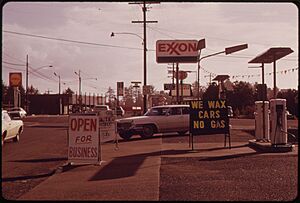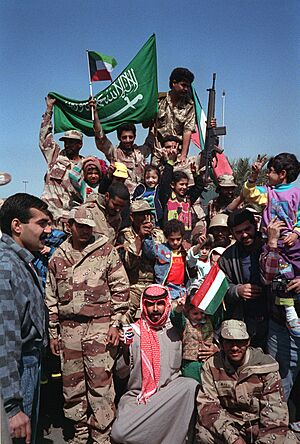Saudi Arabia–United States relations facts for kids
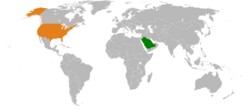 |
|
Saudi Arabia |
United States |
|---|---|
| Diplomatic Mission | |
| Embassy of Saudi Arabia, Washington, D.C. | Embassy of the United States, Riyadh |
The relationship between Saudi Arabia and the United States started in 1933. This is when they officially began working together as countries. Their partnership became stronger in 1951 with a special agreement about defense. Even though Saudi Arabia is an absolute monarchy (ruled by a king) and the U.S. is a republic (ruled by elected officials), they have been allies for a long time. The U.S. helps protect Saudi Arabia. In return, Saudi Arabia provides oil and supports U.S. foreign policy.
Since 1945, the U.S. has often overlooked some of Saudi Arabia's internal policies. This includes how it handles human rights. The main goal was to keep oil flowing and support U.S. security. After the Soviet invasion of Afghanistan in 1979, their friendship grew deeper. Both countries helped Afghan fighters against the Soviet Union. The Gulf War (1990–1991) was a major moment. The U.S., Saudi Arabia, and the UK led a group of countries to stop Iraq from invading Kuwait.
Even with strong ties, there have been disagreements. These include issues with Israel, the 1973 oil embargo, and the 2003 U.S. invasion of Iraq. After the September 11 attacks, Saudi Arabia's role was questioned. In recent years, especially since the Barack Obama administration, the relationship has faced more challenges.
The friendship seemed to get stronger when the Trump administration visited Saudi Arabia in May 2017. However, in October 2018, a Saudi journalist named Jamal Khashoggi was killed in Turkey. This event caused a big problem between the two countries. The U.S. placed sanctions on some Saudi people. Congress also tried to stop selling weapons to Saudi Arabia because of the war in Yemen. But the Trump administration did not agree. Investigators believed the killing was ordered by Mohammed bin Salman, the Saudi crown prince.
During his election campaign, President Joe Biden promised to treat Saudi Arabia differently. The Biden Administration focused on human rights in its relationship with Saudi Arabia. Relations became even more difficult in February 2021. A U.S. report said the crown prince was directly involved in Khashoggi's death. During Russia's invasion of Ukraine, Saudi Arabia did not support U.S. efforts to isolate Vladimir Putin. Instead, they worked with Russia to reduce oil production in October 2022. This caused a strong reaction in the U.S., making relations very tense. U.S. officials criticized Saudi Arabia for helping Russia avoid sanctions. Saudi Arabia also did not support the U.S. policy to limit China's influence. In December 2022, Saudi Arabia welcomed Chinese leader Xi Jinping. They signed a "comprehensive strategic partnership agreement," strengthening ties with China.
Contents
- History of Saudi-U.S. Relations
- Early Days and Official Recognition
- World War II and Oil
- After World War II and the Cold War
- Aramco and Defense
- King Saud's Reign (1953)
- Cold War and Limiting Soviet Influence
- Oil Embargo and Energy Crisis
- The 1980s: Stronger Ties
- The Gulf War
- The 1990s and Beyond
- September 11 Attacks and Their Impact
- 2013: A Small Rift
- 2016 U.S. Presidential Election
- 2017 Arms Deal and War in Yemen
- Jamal Khashoggi Assassination
- 2019 Arms Legislation
- Pensacola Shooting
- Coronavirus Outbreak
- Trade Relations
- Military Relations
- Important Diplomatic Visits
- Public Opinions
- Diplomatic Offices
- See also
History of Saudi-U.S. Relations
Early Days and Official Recognition
King Abdulaziz Al Saud, who founded Saudi Arabia, built close ties with the United States. After uniting his country in 1928, he wanted other countries to recognize it. Great Britain was the first to do so. In May 1931, the U.S. officially recognized Saudi Arabia. Around the same time, King Abdulaziz allowed an American company, Standard Oil of California, to search for oil in the eastern part of the country.
In November 1931, both nations signed a treaty. However, their relationship was still not very strong. The U.S. did not have an embassy in Saudi Arabia. Saudi affairs were handled by the U.S. office in Egypt. In 1943, the U.S. finally sent its first ambassador to Saudi Arabia.
World War II and Oil
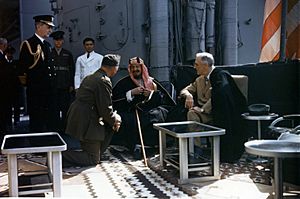
As the U.S. and Saudi relationship slowly grew, World War II began. Saudi Arabia stayed neutral. The U.S. was very busy with the war, so its ties with Saudi Arabia were less important. This left Saudi Arabia open to attacks. Italy, one of the Axis powers, bombed an oil facility in Dhahran. This damaged Saudi Arabia's oil production. King Abdulaziz worried about more attacks. He feared it would stop both oil production and the flow of pilgrims to Mecca, which was important for Saudi Arabia's economy.
However, as the war continued, the U.S. realized how important Saudi oil was. For its own security, the U.S. wanted more control over the oil company. On February 16, 1943, President Franklin D. Roosevelt said that protecting Saudi Arabia was vital for the U.S. He extended a program called Lend-Lease to Saudi Arabia. Later that year, the president tried to create a government company to buy all the oil stock. This plan failed. Roosevelt continued to build relations. On February 14, 1945, he met with King Abdulaziz on a ship. They talked about security and the idea of creating a Jewish country in Mandatory Palestine.
King Abdulaziz allowed the U.S. Air Force to fly over and build airfields in Saudi Arabia. Oil facilities were rebuilt and protected by the U.S. Pilgrim routes were also made safe. The U.S. gained a direct route for military planes going to Iran and the Soviet Union. The first American consulate opened in Dhahran in 1944.
After World War II and the Cold War

After World War II in 1945, some Saudi citizens felt uneasy about U.S. forces staying in Dhahran. But the Saudi government saw U.S. forces as key to its defense. King Abdulaziz changed how U.S. forces were used based on how much danger there was. At this time, the Cold War was starting. The U.S. was worried about the spread of Soviet communism in the Arabian Peninsula. Protecting Saudi Arabia was a top priority for the U.S. government. The Truman administration promised King Abdulaziz protection from Soviet influence. This increased the U.S. presence in the region and strengthened their security partnership.
Aramco and Defense
The trade between the U.S. and Saudi Arabia has always been about two main things: security and oil. Throughout the 1950s and 1960s, their relationship grew much stronger. In 1950, the oil company Aramco and Saudi Arabia agreed to share oil profits equally. In 1951, the Mutual Defense Assistance Agreement began. This allowed the U.S. to sell weapons to Saudi Arabia. It also created a U.S. military training program in Saudi Arabia.
King Saud's Reign (1953)
In 1953, King Saud, King Abdulaziz's oldest son, became king. During his rule, U.S.-Saudi relations faced challenges. President Dwight D. Eisenhower's new anti-Soviet alliance included many of Saudi Arabia's rivals. This made Saudi Arabia suspicious. In October 1955, King Saud joined Egyptian President Gamal Abdel Nasser's pro-Soviet plan. Saud also sent U.S. forces away and replaced them with Egyptian ones. But in 1956, during the Suez crisis, King Saud decided to work with the U.S. again. This happened after Eisenhower stopped Israeli, British, and French forces from taking the Suez Canal.
Cold War and Limiting Soviet Influence
In 1957, King Saud agreed to renew the U.S. base in Dhahran. But less than a year later, after Egypt and Syria joined together in 1958, Egypt returned to its pro-Soviet plan. Saud joined them again, which made U.S.-Saudi relations difficult. This was especially true after Saud said in 1961 that he would not renew the U.S. base. However, in 1962, Egypt attacked Saudi Arabia from bases in Yemen. This was during the 1962 Yemeni revolution. Saudi Arabia had been speaking out against the revolution. This made Saud ask for U.S. help. President John F. Kennedy quickly sent U.S. warplanes in July 1963 to stop the attack. By the end of the war, just before Prince Faisal became king, the relationship between the U.S. and Saudi Arabia improved. In 1962, due to pressure, President Kennedy pushed Saudi Arabia to make "modernization reforms." This included ending slavery in Saudi Arabia.
As the United Kingdom left the Persian Gulf region in the late 1960s and early 1970s, the U.S. did not want to take on new security duties. Instead, the Nixon administration wanted to rely on local allies to protect American interests. In the Persian Gulf, this meant depending on Saudi Arabia and Iran as the "twin pillars" of regional security. In 1970, the U.S. gave less than $16 million in military aid to Saudi Arabia. By 1972, this amount increased to $312 million. The U.S. also tried to improve relations between Saudi Arabia and Iran. For example, they convinced Iran to drop its claim to Bahrain. Rising oil prices in 1970-1971 allowed Saudi Arabia to buy more U.S. weapons. Purchases went from $15.8 million in 1970 to $312.4 million in 1972.
Oil Embargo and Energy Crisis
In November 1964, Faisal became the new king after a conflict with his brother, King Saud. The U.S. was unsure about this change. A difficult time in Saudi-U.S. relations happened when King Faisal decided to stop sending oil to the U.S. and Europe. This was during the Fourth Arab-Israeli War. The oil embargo caused an energy crisis in the U.S. King Faisal told the media, "America's full support for Israel against the Arabs makes it very hard for us to keep supplying oil to the United States, or even remain friends."
During an OPEC meeting in Kuwait on October 16, 1973, Saudi Arabia, Iran, Iraq, Kuwait, Qatar, and the UAE announced they would increase oil prices by 70%. On October 20, 1973, Saudi Arabia stopped all oil shipments to the United States. Because Saudi Arabia had been a close partner since 1945, King Faisal's decision was seen as a very strong move.
The oil embargo lasted until March 1974. It caused the most diplomatic tension the Saudi-U.S. relationship had ever seen. American oil companies in Saudi Arabia came under direct control of the Saudi government. The policies of the Arab oil-producing countries led to a quick rise in oil prices. As the energy crisis hurt the American economy, officials from the Nixon administration threatened Saudi Arabia with direct military action.
Despite the tensions, the U.S. wanted to restart relations. Oil's economic importance became very clear in U.S. foreign policy. The U.S. government began seeking a deeper partnership with Saudi Arabia. The huge oil wealth from higher prices allowed Saudi Arabia to buy many American military technologies. The embargo ended in March 1974 after the U.S. pushed Israel to talk with Syria about the Golan Heights. Three months later, Washington and Riyadh signed a big agreement for more economic and military cooperation. In 1975, the two countries signed $2 billion in military contracts. This included sending 60 fighter jets to Saudi Arabia.
The 1980s: Stronger Ties
Military Sales and Anti-Communism
After the U.S. helped create the Camp David Accords between Egypt and Israel in 1978, Saudi Arabia and the U.S. worked to reduce differences. They deepened their strategic cooperation. Both countries also shared goals like stopping the influence of the Soviet Union during the Cold War. Saudi Arabia increased oil production to stabilize prices and supported anti-communism. This led to closer ties with the U.S. In January 1979, the U.S. sent F-15 fighter jets to Saudi Arabia as part of its anti-communist efforts. Also, both the U.S. and Saudi Arabia supported anti-communist groups in Afghanistan and other countries.

After the Cold War, U.S.-Saudi relations improved. U.S. and Saudi companies worked together on projects in Saudi Arabia and were well paid. Saudi Arabia sent $100 billion to the U.S. for management, construction, weapons, and scholarships for Saudi students in the U.S. During this time, the U.S. built many military academies, navy ports, and airbases. These facilities were designed with U.S. military needs in mind. Saudi Arabia also bought many weapons, like F-15 warplanes and M1 Abrams main battle tanks. These later proved useful during the Gulf War.
In December 2021, the U.S. Senate voted against stopping $650 million in missile sales to Saudi Arabia. This proposal aimed to discourage Saudi Arabia's military actions in Yemen.
Helping Anti-Soviet Fighters
After the Soviet invasion of Afghanistan in December 1979, relations between Saudi Arabia and the U.S. grew even stronger. Both governments worked together to help Afghan fighters. These fighters used guerilla warfare against Soviet forces in Afghanistan.
The Gulf War
Relations between the two nations became even stronger when the U.S. sent nearly 500,000 soldiers to Saudi Arabia. This was to help protect against Iraq. After Operation Desert Shield, which was President George H. W. Bush's response to Iraq's invasion of Kuwait in 1990, America kept 5,000 troops in Saudi Arabia. This was to maintain protection and trade. The Gulf War of 1990–91, which happened at the end of the Cold War, marked a high point in friendly relations between Saudi Arabia and the U.S.
Iraq's invasion of Kuwait in August 1990 led to the Gulf War. The security relationship between the U.S. and Saudi Arabia became much stronger. At the same time, King Fahd declared war against Iraq. The U.S. was worried about Saudi Arabia's safety from Saddam's plan to invade and control the region's oil. So, with King Fahd's approval, President Bush sent a large number of American military forces. By the end of the operation, there were up to 543,000 ground troops. This operation, called Desert Shield, aimed to protect Saudi Arabia from a possible Iraqi invasion. The U.S. sent more troops, and King Fahd sent nearly 100,000 Saudi troops. They formed a U.S.-Saudi army alliance. Along with troops from other allied countries, this alliance attacked Iraqi troops in Kuwait. They stopped further invasion. During the ground part of Operation Desert Storm, Iraqi troops were defeated in four days and went back to Iraq.
The 1990s and Beyond
After the collapse of the Soviet Union in 1991, the United States became the main global power. During the 1990s, Saudi Arabia continued its partnership with the United States.
After the Gulf War, the U.S. kept 5,000 troops in Saudi Arabia. This number grew to 10,000 during the 2003 U.S. invasion of Iraq. Operation Southern Watch enforced the no-fly zones over southern Iraq after 1991. The country's oil exports through the Persian Gulf are protected by the U.S. Fifth Fleet, based in Bahrain.
September 11 Attacks and Their Impact
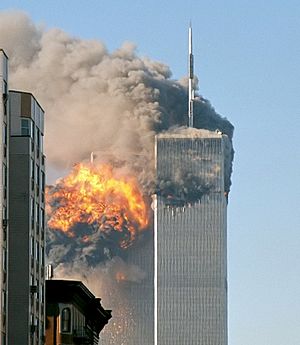
On September 11, 2001, terrorists hijacked four planes. They attacked New York City, Washington, D.C., and a field in Pennsylvania. These attacks killed 2,977 people. They also caused huge damage, more than the Japanese attack on Pearl Harbor 60 years earlier. Fifteen of the nineteen hijackers were from Saudi Arabia. Their leader, Osama bin Laden, was also from Saudi Arabia. In the U.S., this led to much negative attention for Saudi Arabia and its teachings of Islam. People also re-evaluated the "oil-for-security" partnership. A 2002 report found that "for years, individuals and charities based in Saudi Arabia have been the most important source of funds for al-Qaeda." It also said that Saudi officials had ignored this problem.
After the attacks, Saudi Arabia was often seen negatively. Some even suggested taking control of Saudi oil fields.
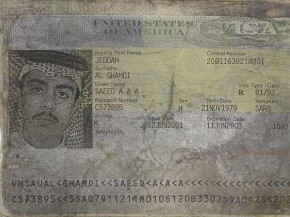
In Saudi Arabia, feelings against America were described as "intense" and "at an all-time high." A Saudi survey after 9/11 found that 95% of educated Saudis aged 25 to 41 supported Bin Laden's cause. (Support for Bin Laden later decreased by 2006, after Al-Qaeda groups attacked inside Saudi Arabia.) The idea of the U.S. taking control of Saudi oil fields spread as a secret U.S. plan.
In October 2001, the Wall Street Journal reported that Crown Prince Abdullah sent a critical letter to U.S. President George W. Bush. He wrote that nations might part ways. He said it was time for the U.S. and Saudi Arabia to look at their separate interests.

For over a year after 9/11, Saudi Interior Minister Prince Nayef bin Abdulaziz Al Saud said the Saudi hijackers were tricked in a Zionist plot. In December 2002, a Saudi government spokesperson said his country was a victim of unfair American intolerance.
In 2003, several terror attacks happened in Saudi Arabia. They targeted U.S. buildings, the Saudi interior ministry, and other places. Because of these attacks, the U.S. decided to help Saudi law enforcement. They provided anti-terrorism training, new technologies, and connections with U.S. law enforcement.
American politicians and media accused the Saudi government of supporting terrorism. They noted that Osama bin Laden and fifteen of the nineteen 9/11 hijackers were from Saudi Arabia.
Some experts believe Osama bin Laden chose 15 Saudi hijackers on purpose. He wanted to break up U.S.-Saudi relations, as the U.S. was already suspicious of Saudi Arabia. The Saudis decided to work with the U.S. on its war on terror. King Abdullah said at a conference in 2005, "Terrorism does not belong to any culture, or religion, or political system." Cooperation grew to include financial, educational, and technological efforts. This was to prevent Al-Qaeda's activities and ideas. Sheikh Saleh bin Abdulaziz Alsheikh, Minister of Islamic Affairs, said it was time for scholars and thinkers to guide young people away from harmful ideas.
Most members of the conference agreed that Al-Qaeda targeted less educated Muslims. They convinced them they were fighting for God, but only used them for political goals. Three years after Saudi Arabia took an active role against terrorism, Al-Qaeda began attacking Saudi government buildings and U.S. compounds in Saudi Arabia. These attacks tried to harm the U.S.-Saudi relationship. They also showed Al-Qaeda's desire for revenge against Saudi Arabia for working with the U.S.
After these changes, the Saudi government was better at preventing terrorist activities. They caught many Saudi and other terrorists (some American) linked to al-Qaeda. Some of these criminals were high-ranking, which helped break up many terrorist groups. In a few months, Saudi officials successfully stopped terrorist activities. They also found the source of terrorist financing.
In March 2018, a U.S. judge allowed a lawsuit by 9/11 survivors and victims' families to proceed against the Saudi Arabian government.
In May 2021, 22 U.S. lawmakers asked President Joe Biden to release secret FBI documents. These documents might show Saudi Arabia's role in the 9/11 attacks. They challenged the "state secrets privilege" used by former presidents to keep the report secret. Evidence of Saudi involvement first appeared in a 2012 FBI memo.
2013: A Small Rift

After 2000, the U.S. found better ways to get oil and gas. It soon became an energy exporter. Instead of buying oil from the Middle East, the U.S. became a competitor. In May 2013, Alwaleed bin Talal warned Saudi ministers that U.S. shale gas production could threaten Saudi Arabia's oil-dependent economy. Despite this, the two countries still had a good relationship.
In October 2013, Saudi intelligence chief Prince Bandar bin Sultan suggested that Saudi Arabia-U.S. relations were drifting apart. This was due to disagreements over the Syrian civil war and U.S. talks with Iran. That month, the Saudis refused a rotating seat on the UN Security Council. This was a protest against American policy on these issues.
Saudi Arabia cautiously supported a temporary agreement with Iran about its nuclear program. President Obama called King Abdullah to tell him about the agreement. The White House said the leaders agreed to "consult regularly" about the U.S. talks with Iran.
The relationship between Saudi Arabia and the U.S. worsened during the last years of the Obama administration. This happened even though Obama allowed U.S. forces to help the Saudis in their military actions in Yemen. He also set up a joint planning group with the Saudi military. The CIA also used Saudi bases for drone attacks in Yemen.
2016 U.S. Presidential Election
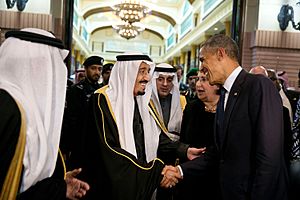
In August 2016, Donald Trump Jr. met with a representative for Saudi Arabia's Crown Prince Mohammad bin Salman. The representative offered to help Trump's presidential campaign. This would have been illegal under U.S. law. The meeting included George Nader, an Israeli social media expert named Joel Zamel, and Erik Prince, who founded Blackwater.
Special Counsel Robert Mueller investigated possible ties between the Trump campaign and Saudi Arabia. A businessman named Ahmad Khawaja claimed that Saudi Arabia and the UAE illegally sent millions of dollars to Trump's campaign.
In April 2017, U.S. President Donald Trump tried to improve relations with Saudi Arabia. He sent the U.S. Defense Secretary to visit the country. Trump said he wanted to help Saudi Arabia with military protection. In return, the U.S. would get economic benefits.
2017 Arms Deal and War in Yemen
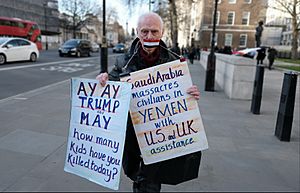
Many Americans have criticized Saudi Arabia's actions in the Yemeni Civil War. This includes accusations of war crimes, such as bombing hospitals, gas stations, and civilian areas. They also used cluster bombs and blocked food and medical supplies, causing a famine. Critics oppose U.S. support for this operation. They say it does not benefit U.S. national security. They also object to the U.S. selling weapons to Saudi Arabia for use in Yemen.

Many lawmakers opposed the 2017 arms deal. This included Republican Senators Mike Lee and Rand Paul, and most Democratic Senators. They voted to block the sale, citing human rights violations by Saudi Arabia.
Tulsi Gabbard, a Democratic Representative, criticized the move. She said Saudi Arabia has a "devastating record of human rights violations" and has supported terrorist groups. Rand Paul tried to block the plan, calling it a "travesty."
U.S. Senator Chris Murphy accused the U.S. of being involved in Yemen's humanitarian crisis. He said, "Thousands and thousands inside Yemen today are dying... This horror is caused in part by our decision to help a bombing campaign that is murdering children."
A June 2022 report said that many airstrikes by the Saudi-led group were done by jets made and sold by U.S. companies. The pilots were also trained by the U.S. military. A study found that airstrikes by the Saudi-led group have killed 24,000 people, including 9,000 civilians.
Jamal Khashoggi Assassination
In October 2018, the assassination of Jamal Khashoggi put the U.S. in a difficult spot. President Trump and his son-in-law Jared Kushner had a strong bond with Mohammad bin Salman. Trump promised to find out what happened and said there would be "severe punishment" if Saudi Arabia was involved. The Saudi Foreign Ministry replied that if Saudi Arabia faced any action, it would respond with "greater action."
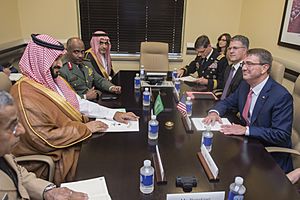
After weeks of denial, Saudi Arabia admitted that Khashoggi died at the Saudi consulate in Istanbul during a "fistfight." Adel al-Jubeir called the death a "murder" and a "tremendous mistake." But he did not know where the body was. The U.S. promised to cancel the visas of Saudi nationals responsible for Khashoggi's death.
In November 2018, Trump defended Saudi Arabia despite its involvement in Khashoggi's killing. Experts said it was impossible for Mohammad bin Salman to visit Washington or have a direct relationship with the Trump administration at that time.
However, in November 2018, relations improved. Trump nominated John Abizaid, a retired U.S. army general who spoke Arabic, as U.S. ambassador. Saudi Arabia also appointed its first female ambassador, Princess Reema bint Bandar Al Saud. This helped calm relations after Khashoggi's death.
On December 12, 2018, the United States Senate Committee on Foreign Relations approved a resolution. It aimed to stop weapon sales related to the Yemen conflict and sanction those blocking humanitarian aid. Senator Lindsey Graham said, "This sends a global message that just because you're an ally of the United States, you can't kill with impunity." He added that the relationship with Saudi Arabia was "more of a burden than an asset."
On April 8, 2019, U.S. Secretary of State Mike Pompeo announced that 16 Saudi nationals involved in Khashoggi's murder were banned from entering the U.S. This included Mohammed bin Salman's close aide Saud al-Qahtani.
2019 Arms Legislation
Because of Saudi Arabia's human rights record, lawmakers in Washington supported a resolution on July 17, 2019. It aimed to block the sale of precision-guided weapons to Saudi Arabia and the United Arab Emirates. This would have stopped billions of dollars in weapon sales for the Saudi-led actions in Yemen, where thousands had died. President Trump vetoed three such resolutions. The Senate did not have enough votes to override his vetoes.
On August 3, 2020, Democrats in Congress issued subpoenas. This was part of an investigation into 2019 U.S. arms sales to Saudi Arabia and the UAE. Democrats demanded that State Department officials testify. This was also related to President Donald Trump firing the State Department's inspector general, Steve Linick, in May.
On August 11, 2020, U.S. Secretary of State Mike Pompeo was cleared of wrongdoing in a disputed arms sale. He had been accused of misusing power. He used an emergency procedure to bypass Congress and sell $8 billion in weapons to Saudi Arabia, the UAE, and Jordan in May 2019.
Pensacola Shooting
On December 6, 2019, a Saudi aviation student named Mohammed Saeed Alshamrani killed three people and injured eight others. This was a terrorist attack at the U.S. Naval Air Station Pensacola in Florida. Alshamrani was a second lieutenant in the Royal Saudi Air Force. He was part of a training program sponsored by the Pentagon. The United States Navy stopped flight training for all Saudi military aviation students during the FBI investigation. Training restarted in late February 2020 after new security measures were put in place.
On July 3, 2020, it was reported that many American diplomats and their families would leave Saudi Arabia. This was because the kingdom was not controlling the coronavirus outbreak well, even after its economy reopened. Some diplomats believed the Saudi government might be reporting fewer coronavirus cases than there actually were.
Trade Relations
Energy and Oil Trade
Since the early 1900s, Saudi Arabia has been an important trade partner for the United States. The main product traded between them is oil. Their strong relationship is well-known because the U.S. needed a lot of oil after the modern era began. Since 2012, about 10,000 barrels of oil are imported daily to the U.S. Saudi Arabia has always needed weapons and support due to rising tensions in the Middle East.
After 2016, the U.S. continued to trade with Saudi Arabia, mostly for oil products. Saudi Arabia's top exports are crude oil, refined oil, and chemicals. Its top imports are cars, planes, medicines, broadcasting equipment, and aircraft parts.
On August 9, 2020, Saudi Arabia announced it would cut oil supply to the U.S. for the third time in a year. This was to reduce oil stockpiles globally and balance supply and demand. Experts said this strategy worked in 2017 when oil demand was high. However, there were challenges in 2020 due to the coronavirus crisis affecting oil demand.
In August 2021, President Joe Biden's national security adviser Jake Sullivan asked OPEC+ to increase oil production. This was to make up for cuts made during the pandemic. On September 28, 2021, Sullivan met with Saudi Crown Prince Mohammed bin Salman to discuss high oil prices. In late 2021, U.S. Energy Secretary Jennifer Granholm blamed OPEC, led by Saudi Arabia, for rising fuel prices in the U.S. The White House warned that OPEC+ risked harming the global economy by not increasing oil production faster.
In March 2022, Saudi Arabia refused U.S. requests to increase oil production. U.S.-Saudi relations had been strained because the Biden administration did not fully support Saudi Arabia's actions in Yemen. In April 2022, CIA Director William Burns traveled to Saudi Arabia to ask bin Salman to increase oil production.
In October 2022, Saudi Arabia suggested the U.S. was focused on short-term political goals. This was about having lower gas prices during the midterm elections. The U.S. protested that Saudi Arabia was helping Russia's invasion of Ukraine by weakening sanctions. A U.S. official said they were "re-evaluating our relationship with Saudi Arabia."
Recent Trade Trends
In 2017, Saudi Arabia was the U.S.'s 20th biggest export market and 21st biggest import market. That year, the U.S. mostly exported aircraft, vehicles, machinery, and arms to Saudi Arabia. U.S. exports to Saudi Arabia dropped about nine percent in 2017 compared to 2016. However, 2017 exports were still 57% higher than in 2007. Imports to the U.S. from Saudi Arabia increased about 11 percent from 2017 to 2018. But this was an overall drop of 47% compared to 2007. What the U.S. imports from Saudi Arabia has not changed much. The top imports in 2017 were mineral fuels (oil), organic chemicals, and aluminum.
Despite disagreements, the U.S. and Saudi Arabia have always been trading partners. During the Syrian Civil War, Saudi Arabia was unhappy that the U.S. did not do more to remove Syrian President Bashar al-Assad. The U.S. has often expressed disapproval of Saudi Arabia's treatment of women. Trade between the U.S. and Saudi Arabia peaked around 2012. It has changed slightly since then, but the overall trend has been positive. In 2001, U.S. exports were $5.9 billion and imports were $13.2 billion. In 2012, these numbers were $17.9 billion in exports and $55.6 billion in imports.
The September 11 attacks caused the most harm to U.S.-Saudi trade relations. This was due to Saudi Arabia's alleged involvement. Tensions also rose during Barack Obama's presidency. The U.S. removed oil sanctions on Iran, allowing them to sell oil. The relationship also suffered from the oil market crash of 2014. This was caused by more shale oil production in the U.S. Saudi Arabian oil exports dropped by nearly 50%. Oil prices went from about $110 a barrel before 2014 to about $27 a barrel by early 2016. The trade relationship worsened after the U.S. Congress passed a bill in 2016. This bill allowed 9/11 victims to sue the Saudi Arabian government for their losses.
Military Relations
Gulf War
In early 1990, Iraq invaded Kuwait. The U.S. and its allies eventually pushed the Iraqis out and freed Kuwait.
2010 U.S. Arms Sale
On October 20, 2010, the U.S. State Department told Congress about its plan for the biggest arms sale in American history. Saudi Arabia planned to buy an estimated $60.5 billion in weapons. This package would greatly improve the Saudi armed forces' ability to attack.
The U.S. emphasized that the arms transfer would make it easier for U.S. and Saudi forces to work together. In the 1990–1991 Gulf War, American forces could operate in a familiar environment. This was because Saudi forces had been trained by the U.S. and built military bases to U.S. standards. The deal aimed to increase this cooperation.
2017 U.S.–Saudi Arms Deal
On May 20, 2017, U.S. President Donald Trump approved a nearly $110 billion arms deal with Saudi Arabia. This deal was worth $300 billion over ten years. It included training and close cooperation with the Saudi Arabian military. The signed documents were letters of interest and intent, not actual contracts. U.S. defense company stocks reached record highs after this deal was announced.
Saudi Arabia signed billions of dollars in deals with U.S. companies. These included companies in the arms industry and petroleum industry. Some of these companies were Lockheed Martin, Boeing, Raytheon, and ExxonMobil.
In August 2018, a U.S.-sold, Lockheed Martin-built laser-guided bomb was used. It was in a Saudi-led airstrike on a school bus in Yemen. This attack killed 51 people, including 40 children.
On May 27, 2020, Bob Menendez, a Democratic Senator, claimed that the Trump administration was secretly planning to sell $1.8 billion worth of weapons to Saudi Arabia.
Democratic Senators Bob Menendez, Patrick Leahy, and Tim Kaine planned to introduce a law. It would place strict human rights rules on arms sales to countries with poor human rights records, like Saudi Arabia and the United Arab Emirates. President Trump was also criticized for declaring an emergency to bypass opposition. This allowed him to sell billions of dollars in weapons to Saudi Arabia and the UAE, who were accused of war crimes.
Important Diplomatic Visits
After President George W. Bush visited Saudi Arabia twice in 2008, and King Abdullah visited the U.S. three times (2002, 2005, 2008), relations were at their best. The two nations expanded their relationship beyond oil and fighting terrorism. For example, King Abdullah provided money for young Saudis to study in the U.S. One main reason was to give them a Western view and create a good impression of Saudi Arabia in America. President Bush discussed the world economic crisis and how the U.S.-Saudi relationship could help. During meetings, the Bush administration took Saudi policies very seriously. This was because of their economic and defense importance in the region, and their influence in the Islamic world. The two leaders made many decisions about security, economy, and business.
In early 2018, Crown Prince Mohammad bin Salman, who speaks English well, visited the U.S. He met with many top politicians, business people, and Hollywood stars. These included President Donald Trump, Bill and Hillary Clinton, Henry Kissinger, Bill Gates, Jeff Bezos, and George W. Bush.
Public Opinions
Historically, surveys have shown negative feelings between the people of the two nations. This is true even as their governments' relationship changed. Polls of Saudi Arabian citizens in 2002 found that 51% had a negative view of Americans. A BBC poll from 2005-2006 found that Saudi public opinion was split. 38% viewed U.S. influence positively, and 38% viewed it negatively.
However, as of July 2022, 92% of young Saudis saw the United States as an ally. In 2019, Saudi Arabian students were the 4th largest group of international students in the U.S. They made up 3.4% of all foreign students in higher education. A December 2013 poll found that 57% of Americans had a negative view of Saudi Arabia. Only 27% had a positive view. A July 2021 poll estimated that 50% of Americans saw Saudi Arabia as at least a necessary partner.
After the OPEC oil cut in October 2022, a survey of Americans found that 49% viewed Saudi Arabia as "either unfriendly to or an outright enemy" of the U.S. A 2022 poll found that most Saudi citizens (59%) preferred aligning with the Russia–China group over the United States. Only 41% of Saudi citizens described relations with the U.S. as "important." This was behind China (55%), Russia (52%), and the European Union (46%).
Diplomatic Offices
- Saudi Arabia has an embassy in Washington, D.C. and consulates in Houston, Los Angeles, and New York City.
- The United States has an embassy in Riyadh and a consulate in Jeddah.
See also
- Foreign relations of Saudi Arabia
- Foreign relations of the United States
- Embassy of Saudi Arabia, Washington, D.C.
- List of ambassadors of Saudi Arabia to the United States
- List of ambassadors of the United States to Saudi Arabia
- Saudi Arabia lobby in the United States




